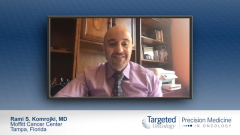
Novel Therapies Being Investigated in Polycythemia Vera
Before closing out their review of polycythemia vera management, expert hematologist-oncologists highlight novel therapies in the pipeline.
Episodes in this series

Transcript:
Rami S. Komrokji, MD: What are some of the other strategies or the ongoing studies with the rusfertide®, the PTG-300 that has been- is in development in for patients with polycythemia vera.
Pankit Vachhani, MD: Yes, many options. In polycythemia vera. And rusfertide® or PTG-300, this is a non-cytoreductive drug, which is a hepcidin mimetic. In other words, it plays a role and works on the iron homeostasis. Recently we have seen results from the 2 phase 2 trials of rusfertide®, REVIVE and PACIFIC, which were done in patients who had excessive erythrocytosis despite therapeutic phlebotomies plus minus cytoreductive agents. And what was seen in these two trials was that rusfertide or PTG-300 virtually eliminated the need and brought the hematocrit levels down rather robustly and fast, in both the studies. It did not have any major concerning grade 3 or 4 adverse events. The ones which were there were mostly grade 1 or grade 2. Additionally, what we have also seen very recently is that when rusfertide® is held, the improvements are reversed. The therapeutic phlebotomy requirement increases, hematocrit increases, serum ferritin drops, but re-initiating rusfertide normalizes these hematologic parameters. What that suggests is that rusfertide® may be a good drug for decreasing the therapeutic phlebotomy requirements, keeping hematocrit under control. It is not a cytoreductive drug, it won't have an effect on the white blood count or even platelet counts, but it will help with the iron homeostasis. And hopefully the phase 3 trials will establish a role down the line. But in addition to that, there are many other drugs under investigation in various phases. We have seen in some results and talked about MDM2 inhibitors, which work through the P53 pathway for example. Idasanutlin® and navtemadlin® are 2 of those drugs. There are the JAK2 Keller vaccine developments. For PV of course, the JAK2 vaccine component would be the- of most importance. There are LST1 inhibitors, which are in the development process. And if I may, I would bring up and say that givinostat® or givinostat® and HDAC inhibitor, which selectively targets the JAK2 V617F cell growth also seems to be demonstrating very good efficacy and safety in multiple studies with polycythemia vera. Things to look out for, and I'm sure the field will get exciting over there down the line.
Transcript edited for clarity.











































